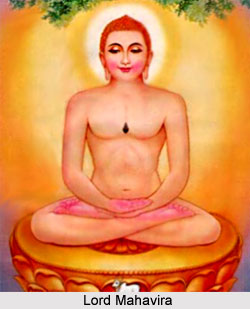 Lord Mahavira became an ascetic at the age of thirty. Before he became an ascetic an important event took place in his life. His meeting with Gosala Mankhaliputta, the head of the Ajivika sect was a very influential event in his life. The fifth Anga of the Jainas, known as the Bhagavati Sutra, has provided a detailed account of the life of Gosala. Many other ascetics of Ajivikism existed before Mankhaliputra Gosala and he considered himself to be the twenty-fourth Tirthankara of the current Avasarpini age. According to Tamil sources he was named as Markali. In Buddhist Sanskrit literature he is known as Maskarin Gosalal, Gosalikaputra, Gosaliputta and Moghapurusa.
Lord Mahavira became an ascetic at the age of thirty. Before he became an ascetic an important event took place in his life. His meeting with Gosala Mankhaliputta, the head of the Ajivika sect was a very influential event in his life. The fifth Anga of the Jainas, known as the Bhagavati Sutra, has provided a detailed account of the life of Gosala. Many other ascetics of Ajivikism existed before Mankhaliputra Gosala and he considered himself to be the twenty-fourth Tirthankara of the current Avasarpini age. According to Tamil sources he was named as Markali. In Buddhist Sanskrit literature he is known as Maskarin Gosalal, Gosalikaputra, Gosaliputta and Moghapurusa.
Mankhali was the father of Gosala who was a poor, wandering poet, who managed to meet both ends by singing heroic songs or ballads. He also exhibited pictures related to his songs. The saint was named as Gosala as he was born in a cowshed of a rich Brahmin, Gobahula. His parents had taken shelter there as they could not find any other place for refuge during a certain rainy season.
He was born at Saravana near Sravasti and brought up in Kosala. His headquarters was situated in the Kosalan capital (Sravasti), where he was basically respected. According to Bhagavati Sutra, before Gosala met Lord Mahavira he remained engaged in the profession of a mankha, with a picture board in his hand. It is thus eminent that from the very beginning of his career he had developed an aversion towards worldly life.
During the second year of the ascetic life of Gosala met Mahavira in Nalanda were he was wandering. He took shelter in the same shed where Mahavira was staying. Gosala was aware of Mahavira`s glory and his extraordinary life style. He was very impressed by his way of life and expressed his desire to become his disciple. He was however refused by Mahavira. Later Gosala again prayed to Mahavira for taking him as his disciple but he was refused once more. Mahavira continued his wanderings and went to Kollaga, near Nalanda. Gosala went behind him but being refused was very disappointed. He then returned back to his shed and began leading an ascetic life. He gave up his clothes, vessels and also shaved off his hair and beards. He later met Mahavira at Paniyabhumi where he again prayed for his admission into his new and inspiring sect. This time his prayers made the desired effect and Mahavira accepted him. They together lived together for six years in Paniyabhumi practising asceticism. According to Bhagavati Sutra Mahavira and Gosala left Siddhattagrama for Kurmaragrama during the season of Sarada.
Doctrines of Gosala
The doctrines of Gosala were based on a main principle of Niyativada. He strongly believed that Niyati was the ultimate thing that controlled every action and phenomenon. There is actually no room for man`s free will and control. All beings (satva), life, (prana), substance (bhuta) and existence (jiva) are caused by fate. Thus according to this principle there is no room for any human effort and will power. This theory is ineffectual and was in contrast to the theories of Mahavira. Goshala`s theory of reanimation and other doctrines also did not match with Mahavira who believed in the freedom of the will. Gosala, then, served his association with Mahavira and declared himself as a Jina at Sravasti. Mahavira on the other hand had to wait for another six years for attaining the stage of perfection.
Gosala became teacher at least two years before Mahavira. However, the Bhagavati and Kalpa Sutras differ in their viewpoints of Gosala`s life. According to the former Mahavira spent six years in Paniyabhumi with Gosala, the latter gives him only one year for that place, but six years for Mithila. However, it can be concluded that in the second year of his monkhood, Mahavira parted with Gosala because of differences of opinions. Mahavira later established a new school of his own and organised a religious order almost based upon Parshvanatha`s model.
The Jain Swetambara literature believes that Mahavira was the `guru` of Gosala. Even the Jain scriptures also state that Gosala`s system was taken from the eight mahanimittas, a portion of the Purvas. These Purvas were believed to be the original sacred texts taught by Mahavira. While dying Gosala also accepted that he was the disciple of the Lord Mahavira.









